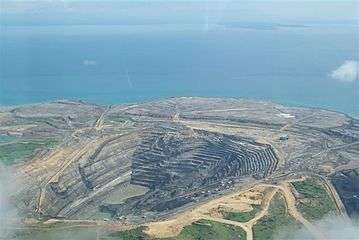Coal mining in the Philippines

Coal mining in the Philippines has a long history dating back to the 1800s during the Spanish colonization of the islands. The Philippines consumes more coal than it can produce and coal accounts for most of the country's power generation at 27 percent in 2005. 20 percent of the country's coal supply is used by the cement industry, also in 2005.[1]
As of 31 September 2005, the in-situ coal reserves of the Philippines amounts to 458 million metric tons which is about 18 percent of the country's total coal resource potential amounting 2.53 billion metric tons.[1]
Seventy-five percent of the country's coal supply composes of imported coal. In the 1990s, the country saw increase in the importation of coal due to large coal-fired power plants being built in the country designed to burn imported coal.[2]
Semirara Mining Corporation is the largest coal producer in the country whose primary mine is in Semirara Island. The company accounts for 92 percent of the country's coal production according to the Department of Energy.[3][4]
History
Early history
Coal was first discovered in the Philippine islands in 1827 in the island of Cebu although there was little interest from the Spanish colonial government or private individuals to exploit the resource until the arrival of steamships in the archipelago. In October 17, 1842, Governor General Marcelino de Oraá Lecumberri issued a circular to alcaldes mayores and other provincial authorities regarding information about possible coal deposits in their area. While some areas report of coal deposits, there is minimal commercial exploitation of the resource. In the island of Cebu, where coal was first discovered in the islands, it was only in 1853 when the first coal concessions were granted in the island.[5]
Starting from 1853 until 1860, saw the development of the coal-mining industry in the islands especially in the island of Cebu. The colonial government effectively had a monopoly of the industry especially after the coal mine in Guila-Guila in Cebu was put under control of the state.[6]
References
- 1 2 "Energy Resources - Coal". Department of Energy. Retrieved 21 December 2015.
- ↑ "Coal in the Philippines". World Coal. Palladian Publications Ltd. 26 March 2013. Retrieved 21 December 2015.
- ↑ "Case Study of Coal Mining on Semirara Island" (PDF). Philippine Movement for Climate Justice. Retrieved 21 December 2015.
- ↑ Macas, Trisha (17 July 2015). "FACTSHEET: The DMCI-owned Semirara Mining Corporation". GMA News. Retrieved 21 December 2015.
- ↑ Burritt, Charles H (1901). "Historical Sketch of the Discovery in the Philippines". The coal measures of the Philippines : a rapid history of the discovery of coal in the archipelago and subsequent development, with the full text of the record of the MacLeod coal concession in Cebu, of the Uling-Lutac coal and railway concession. Washington, D.C: United States Division of Insular Affairs. pp. 8–10. Retrieved 21 December 2015.
- ↑ Burritt, Charles H (1901). "The Dawn of the Coal-Mining Industry 1853-1860". The coal measures of the Philippines : a rapid history of the discovery of coal in the archipelago and subsequent development, with the full text of the record of the MacLeod coal concession in Cebu, of the Uling-Lutac coal and railway concession. Washington, D.C: United States Division of Insular Affairs. pp. 16–34. Retrieved 21 December 2015.